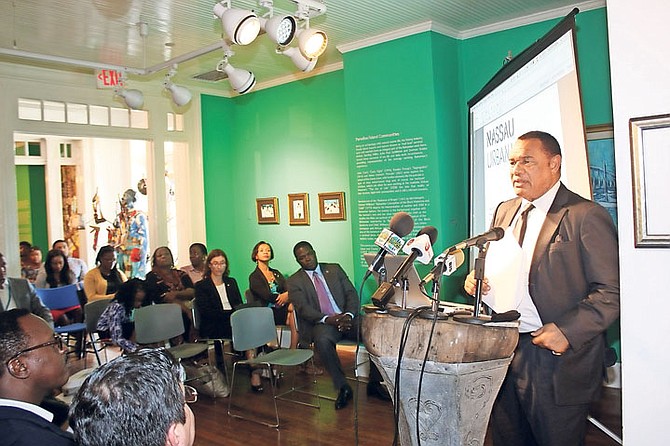By RICARDO WELLS
Tribune Staff Reporter
rwells@tribunemedia.net
THE city of Nassau and the historic Grants and Charles Towns communities could undergo major overhauls in the coming years if the government decides to move forward with plans presented by the Economic Development Planning Unit on Thursday.
The “Sustainable Nassau Initiative”, hailed by Prime Minister Perry Christie as a saving grace for several Over-the-Hill communities, was officially unveiled yesterday by officials at a ceremony at the Nassau Art Gallery on West Street.
The project aims to provide a roadmap for developments in inner-city communities over the next several decades, ensuring for the first time in the history of New Providence, systematic town-planning effort.
Mr Christie said the renaissance of Nassau has been overdue. He said that in many ways the heart of the nation in recent times has become the face of poverty and decay.
“The city that we are building must be one that is alive, with exciting cultural activities, opportunities for wealth creation for our young people, and hubs for creativity and innovation so that the country will retain the local talent needed to grow our economy,” said Mr Christie.
He put forth that through this initiative, The Bahamas could attract the international resources it needs to thrive.
Mr Christie continued: “Today’s event, together with the workshops and meetings that were held this week, will conclude the second component of the sustainable Nassau initiative. This component of the project has resulted in the engagement of a wide range of stakeholders from both public and private sectors and people living in our most historic, Over-the-Hill communities.”
Mr Christie indicated that from the insight gained through these processes, together with the results of the phase one baseline studies on greenhouse gas emissions, environmental hazard mapping and urban growth and land use, the country will prioritise the areas and sectors where critical action and investment are necessary.
“This will not be a plan that sits on a shelf and never sees the light of day,” he insisted.
“Rather, this will be an action plan that is available to the public so that we can always keep sight of where we want to go and the steps we must take to get there.”
“The world will also be able to see where Nassau stands compared to its peers in the region, via the Urban Dashboard platform that tracks the performance of the over sixty cities in the region participating in the IDB’s Emerging and Sustainable Cities programme,” he added.
“We will put this plan into action to produce tangible results that the Bahamian people can see, touch and feel. Our citizens, residents and visitors are deserving of an efficient and reliable public transportation system.
“A sustainable waste management system is long overdue. Public spaces, accessible to all persons regardless of physical ability, should facilitate the exchange of ideas and expressions of our culture and talents. We must leverage technology and smart applications to improve service delivery by government, making it easier and cheaper to do business.”
Dr Nicola Virgil-Rolle, director of economic development planning and government aide to the Inter-American Development Bank, said the proposal presented by her unit looked to build upon a concept already in place.
She maintained that the cultural and community aspects of many of the areas is part of the plan and would “certainly” remain.
“We wanted to keep the cultural and community elements that these communities are known for while generating a renewed sense of life in and around these areas,” she said.
Mrs Virgil-Rolle added: “So many Bahamians, great Bahamians were born and raised in these areas and we want to find ways to encourage them or others to return here and help build on that next historic wave in our country.”
“We proposed housing projects, and these are developments not unto themselves; but projects centred on communities, green spaces, and infrastructural facilities. You see, what we envision for these areas are fully capable cities and towns – modern cities and towns.”
The project, which commenced with a wide range of economic and infrastructural studies last September, was financed through a grant fund of $1.1m by the IDB.





Comments
Use the comment form below to begin a discussion about this content.
Sign in to comment
Or login with:
OpenID